The Blame Game
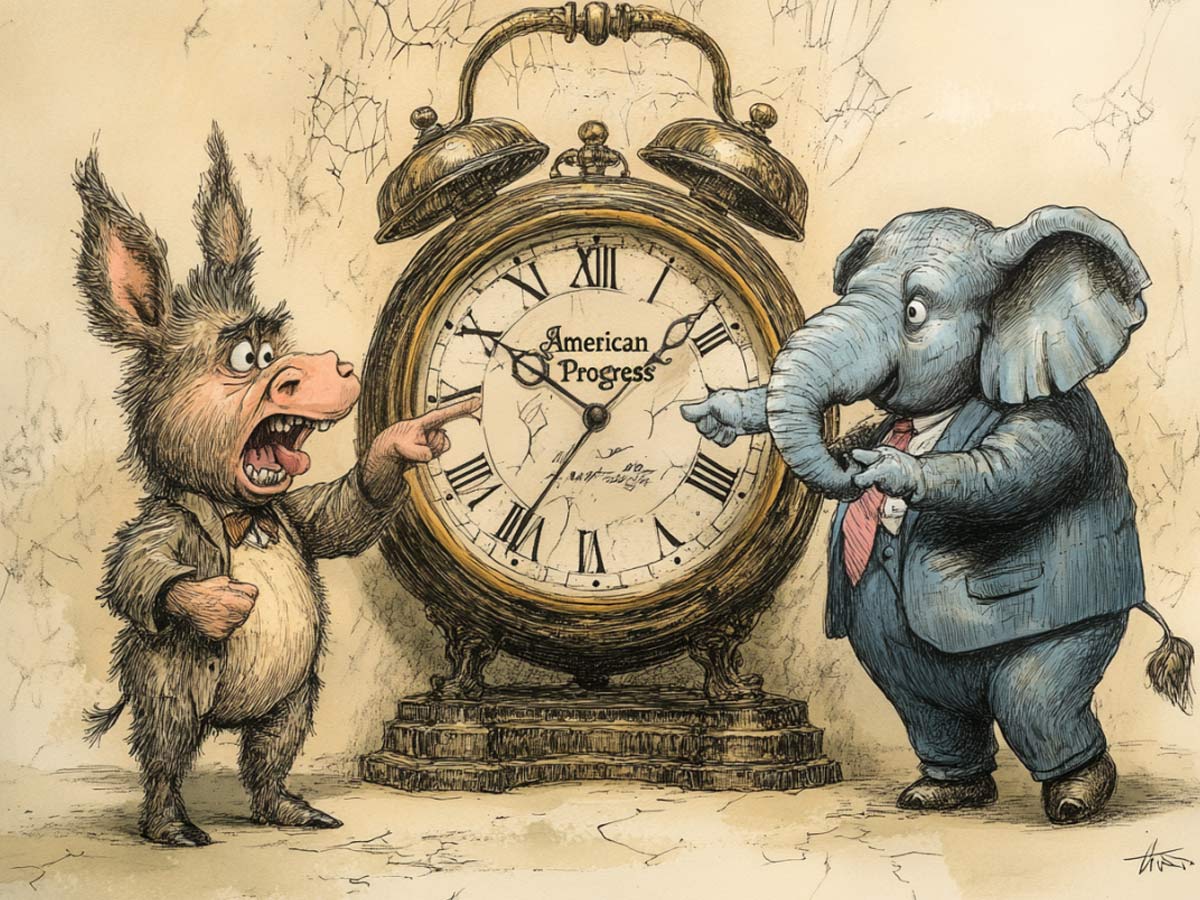
Here, we see the parties represented by their animal symbols wearing suits. They stand pointing accusatory fingers at each other, blaming each other for problems, much like actual Democrats and Republicans. Behind them stands a clock with the words “American Progress” written in the middle.
One interpretation is that the clock is going backwards to represent our country going back in time and not making any progress due to our current two-party system. That, or it represents an alarm clock for American progress about to sound off, but the parties aren’t ready to act on it – they’re too busy pointing fingers! Either way, it’s clear that our current system spends way too much time picking fights.
Asleep at the Helm: How Old is Too Old?

This cartoon depicts a row of old politicians falling asleep on the job. Recent events have highlighted the increasingly popular belief that certain government positions should have age limits to ensure politicians’ beliefs are up to date with the rest of the country.
It’s safe to say that someone born in the 1930s and 1940s probably doesn’t care about modern problems the same way the rest of us do – they won’t have to deal with the consequences soon!
Manipulating the Masses
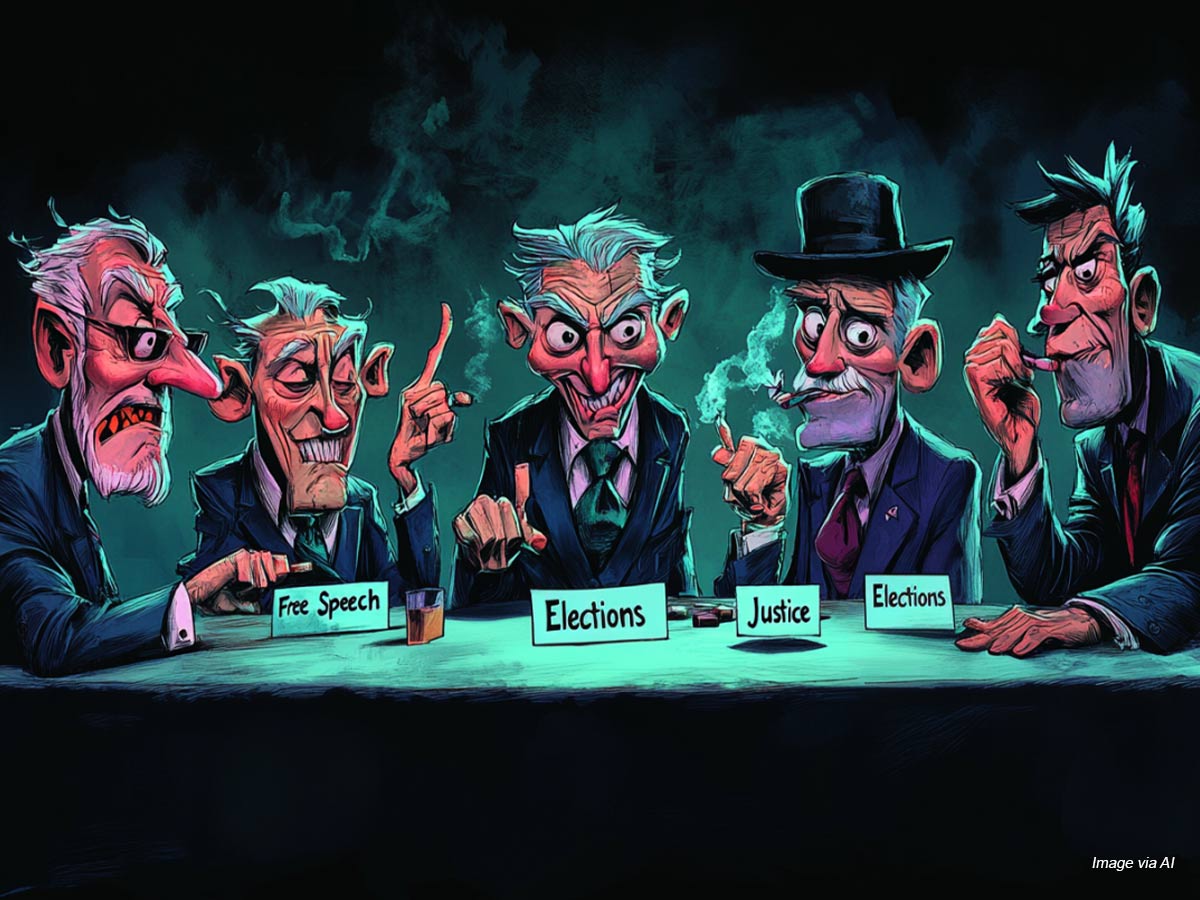
Here we have a group of people gathered around a table, smoking cigars and discussing politics.
Free speech, elections, justice – some say it’s all being coordinated by a small group of wealthy people willing to gamble for what they want, not what the public wants.
The Seesaw of Compromise
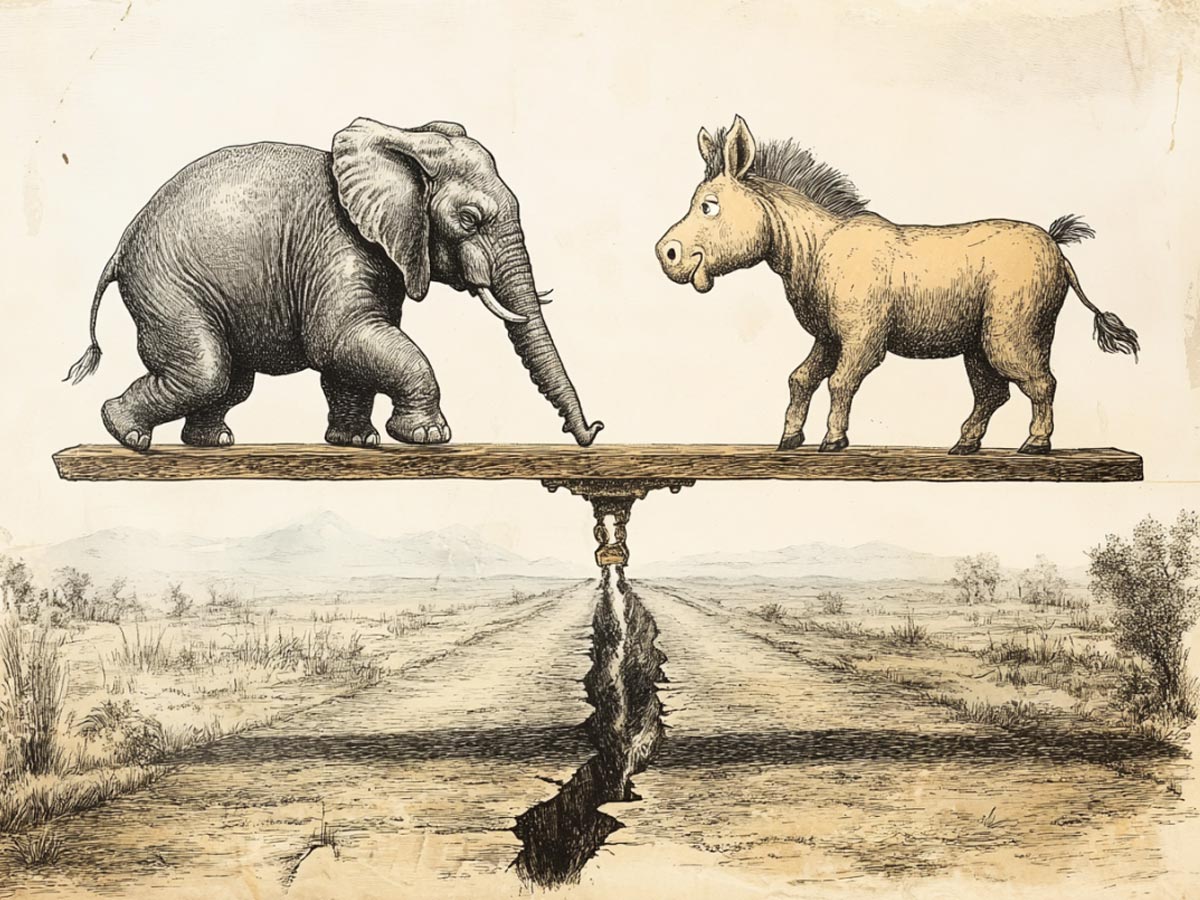
In this cartoon, the two parties are seen balancing on a seesaw. While they’re busy doing that, the ground below them is desolate, with a huge rift forming between them.
The two-party system spends too much time trying to maintain balance when it should be concerned about more important matters.
Budget Pie
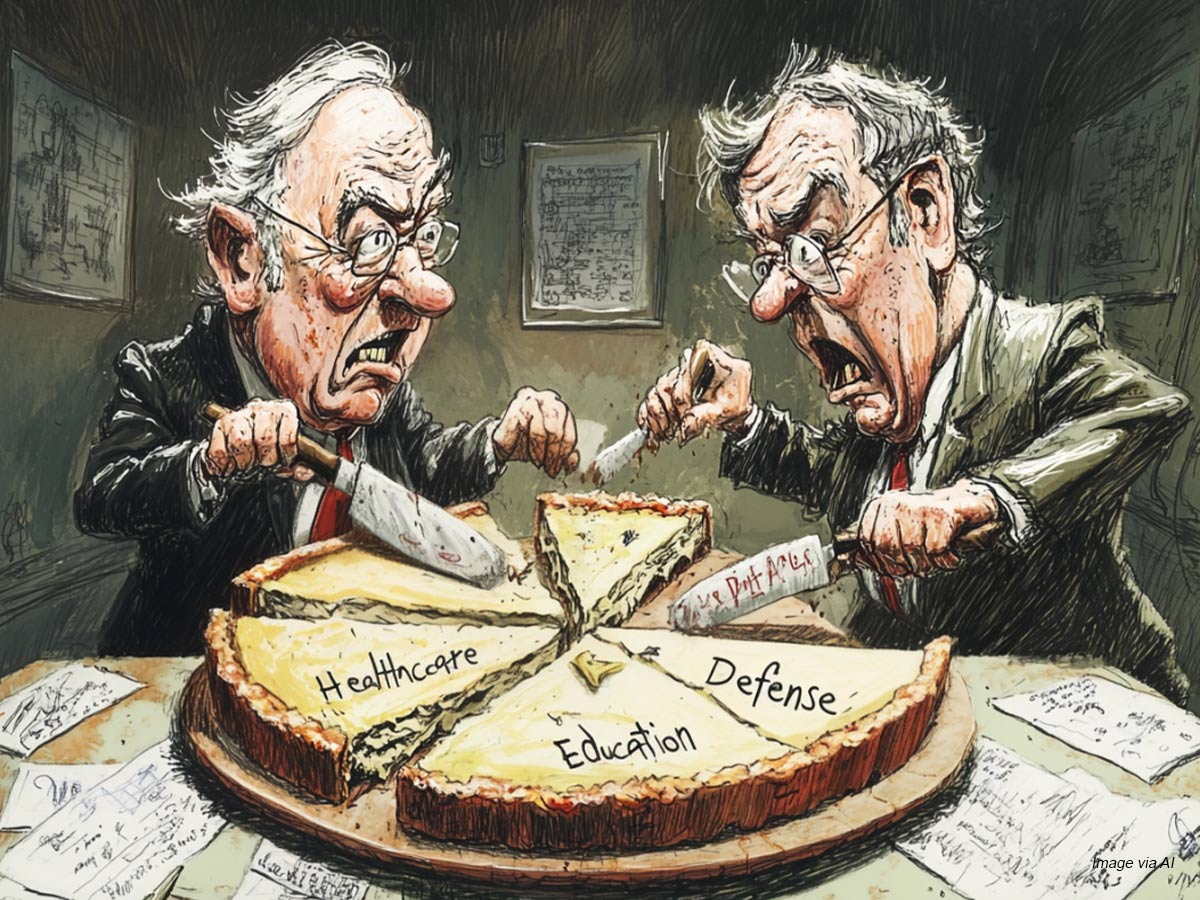
We all know America’s budget is flawed. Our money isn’t going where we want it to. While the rest of us are fighting over whether our taxes should go to healthcare, education, and anything else that might improve our daily lives, a select few people are gobbling up the budget.
War, rockets, colonizing Mars, you name it. Some rich person is getting a politician to snatch up the country’s budget and return for seconds!
Rats Guard the Cheese
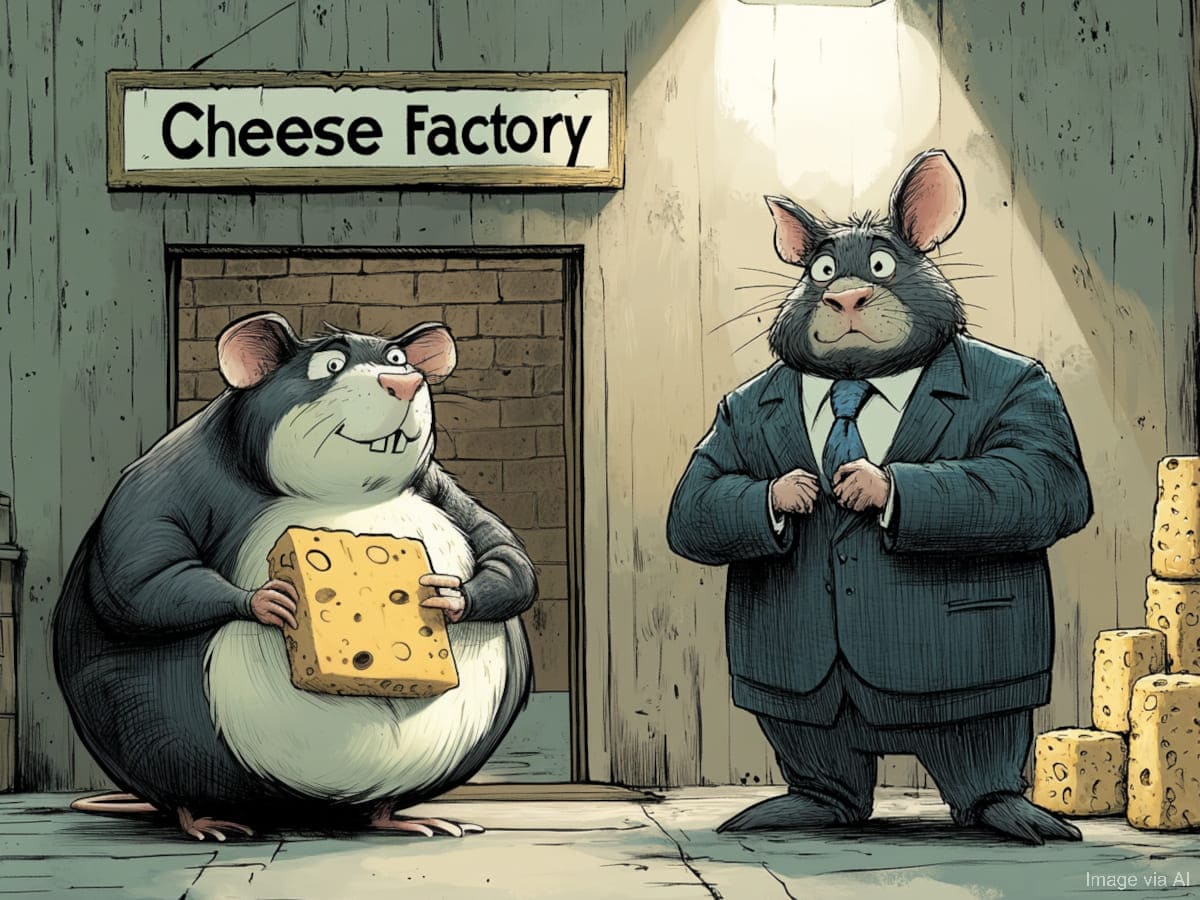
This cartoon shows two rats standing in a "Cheese Factory." One rat is big and happy, holding a piece of Swiss cheese, while the other rat is dressed in a fancy blue suit and tie, looking serious and business-like. Behind them, there are stacks of cheese blocks neatly piled up. Cheese is a symbol for money or wealth. The big, cheerful mouse holding the cheese could represent people who already have plenty of wealth and are enjoying it.
The mouse in the suit represents the ones in charge, making sure the cheese stays protected and doesn’t get shared with those who need it. Together, they seem to be guarding their cheese, keeping it all for themselves. This image is a clever way of showing how some people hoard wealth and protect it, making it harder for others to get a share. It’s a playful but sharp take on how money and power often work in the real world.
Stockholm Sheep

"He tells it like it is." The scene is rich with metaphors, inviting interpretations that span the political spectrum. For Democrats, the cartoon critiques blind trust or misplaced faith in leaders who promise straightforwardness but may harbor ulterior motives. The sheep’s smile might reflect a gullible nature or a blind willingness to accept surface-level messaging without questioning the deeper implications.
For Republicans, the wolf might symbolize a charismatic, unapologetic leader who appeals to the base with blunt rhetoric. It is often celebrated for "telling it like it is," even when the message may be self-serving or predatory. The sheep represents voters who embrace this figure, perhaps overlooking the inherent risks in favor of the wolf's perceived authenticity. It doesn't matter which side of the aisle you're on, this cartoon captures the absurdity of American political allegiance.
Beware the Inflation Monster

This image shows inflation as a big, scary monster. The machine on the left looks like a wild, out-of-control beast with pipes and parts everywhere. It stands for the complicated systems that cause inflation. On the right, a creature with big, wide eyes and the word "inflation" makes it seem like the monster is watching and ready to attack.
Stacks of money sit below the monster, showing how inflation makes money pile up but lose its value. A person in a suit stands nearby, looking small and unsure, like they don’t know how to stop the problem. The dark blue and green colors in the background make the scene feel serious and a little scary. This cartoon shows inflation as a powerful monster that hurts the economy while leaders struggle to fight it.
Our Fires Burn Other Worlds Down

This image of a bear standing on a cliff, overlooking a city engulfed in smoke and flames, serves as a powerful metaphor for the global impact of American politics. The bear, a symbol of strength and dominance, could represent the United States, standing tall and seemingly unaffected while chaos unfolds below. The destruction in the background—burning buildings and rising smoke—reflects how decisions made in American political arenas often ripple across the world, influencing economies, conflicts, and environmental policies far beyond its borders.
Policies on trade, military intervention, or climate change, while debated domestically, can ignite consequences that devastate other nations. The bear’s position on the cliff suggests a sense of detachment or even indifference, highlighting how the U.S. can sometimes overlook the far-reaching effects of its actions. American politics doesn’t exist in a vacuum; its fires, whether intentional or not, can burn down worlds far from its own shores.
Hard to Get on the Debate Stage

The blue and red characters on one side clearly represent the two dominant political parties, Democrats and Republicans, while the green and yellow figures on the other side could symbolize third-party candidates or alternative viewpoints often overshadowed in the political arena. The podium at the center highlights the idea of public discourse, where these groups are meant to present their ideas and challenge one another.
However, the simplicity of the characters might also poke fun at the performative nature of debates, where theatrics and soundbites often take precedence over meaningful discussion. The image captures the tension and division of American politics, where diverse voices compete for attention but are inevitably drowned out by the two major players.
Lady Liberty
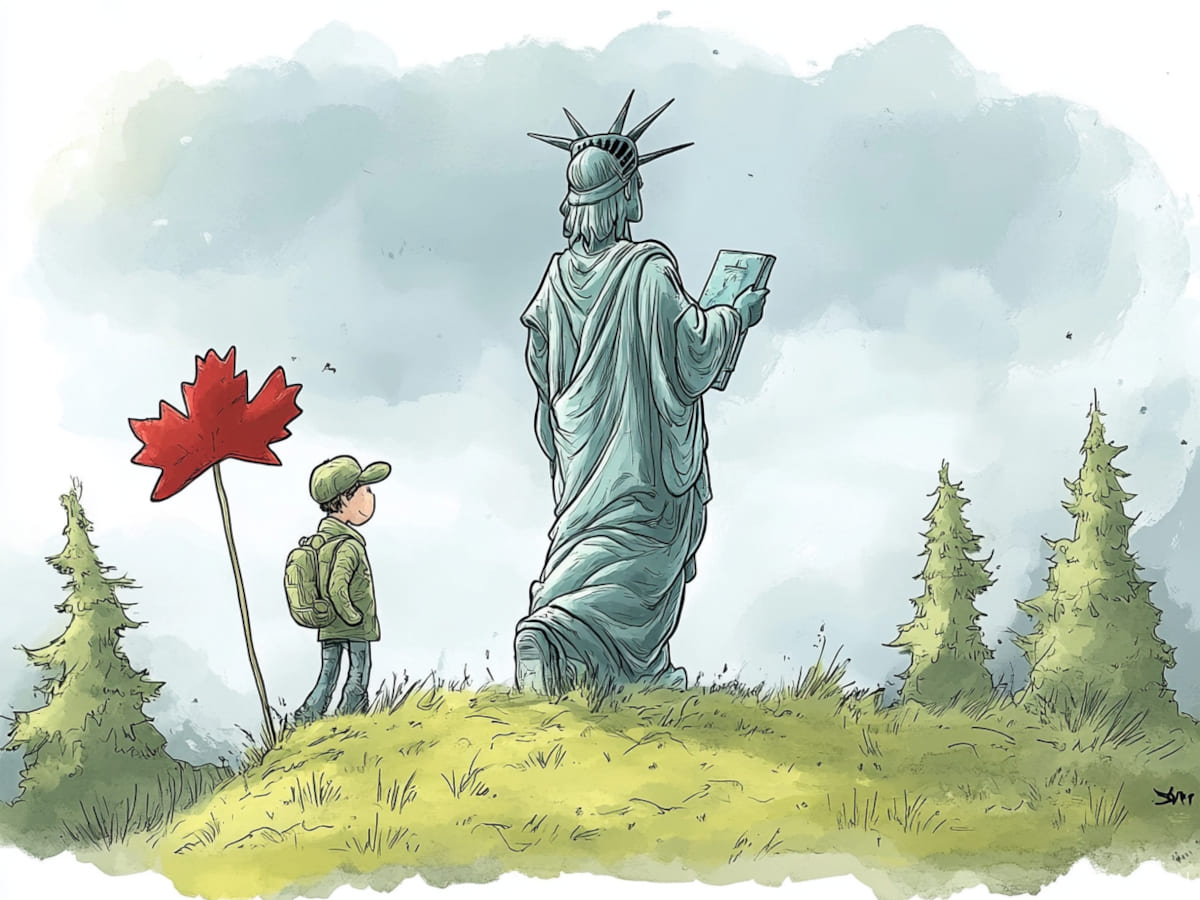
Lady Liberty, typically a beacon of freedom and welcome, is depicted standing in a natural, Canadian landscape, far from her usual urban home. The child with a green cap and backpack, standing nearby and gazing up at her, represents Canada—innocent, curious, and perhaps unaware of the implications of this iconic figure’s arrival.
Ironiclly, America's symbol of liberty and welcome being used as a tool of infiltration, hinting at the absurdity of a U.S. president’s hypothetical desire to annex Canada. This satirical take critiques the idea of expansionism, flipping the Statue of Liberty’s meaning to highlight the tension between ideals of freedom and the reality of political ambition.
Kneel Before False Kings
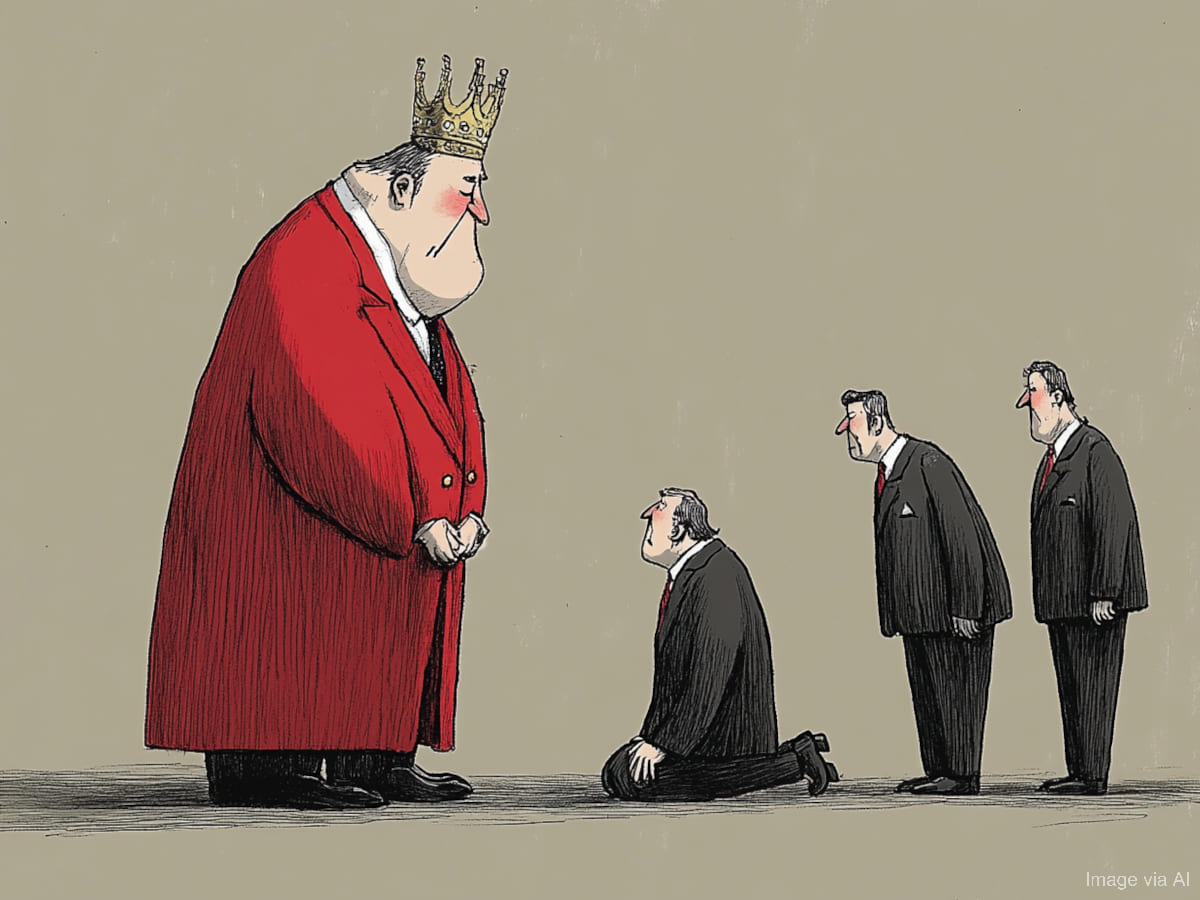
This cartoon shows a big, powerful figure wearing a red coat and a crown, standing over three smaller people in suits. The big figure looks serious and in charge, while the smaller people seem to be showing respect or even bowing down, with one of them kneeling. The image is a clever way of showing how power works in politics.
It’s a simple but powerful way to get people thinking about how loyalty and power play out in American politics. The big figure might remind people of a toxic leader who demands loyalty, with followers who stick by them no matter what. It could be a warning about blindly following leaders and the risks of giving too much power to one person. The bright red coat of the leader stands out against the dull colors of the others, making the difference in power really clear.
Choose Your Own Path

This cartoon cleverly compares two paths, each framed by an archway, to the choices voters face in politics. On the left, under the label "The Same," a person in a red coat walks toward a dull, grey city filled with tall buildings. The scene feels lifeless and repetitive, with others heading in the same direction. This side represents sticking with the status quo—voting for the same political parties or leaders who promise stability but deliver little change.
Under the label "Change," symbolizes breaking away from the usual political choices and embracing new ideas or leaders who challenge the norm. The cartoon highlights how voting for the same parties over and over can feel safe but often leads to stagnation. Choosing change, while uncertain, offers the chance for fresh perspectives and real progress. It’s a reminder to voters that stepping away from the familiar can lead to a brighter, more dynamic future.
Don't Cut Off Your Nose
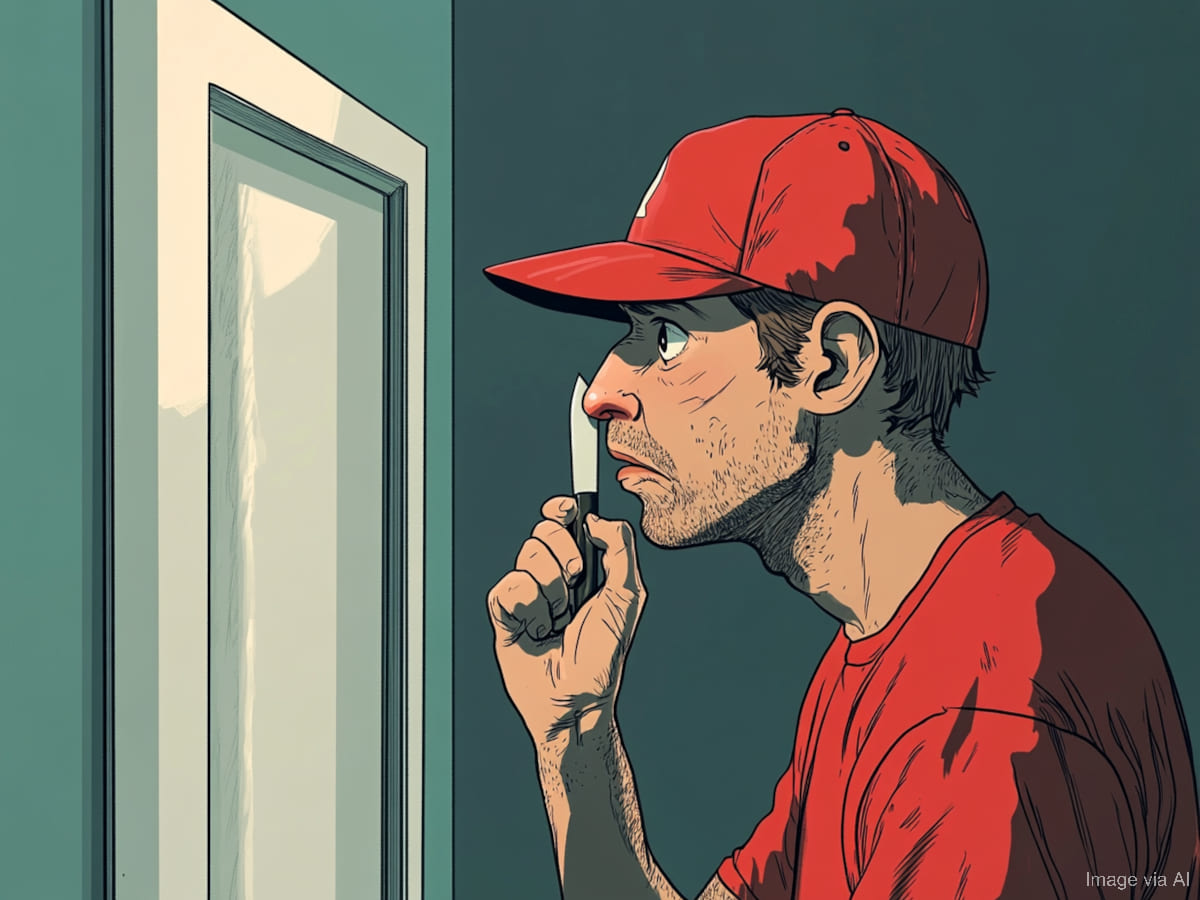
The phrase "don’t cut off your nose to spite your face" comes to mind when interpreting this image. It could be a commentary on how political decisions, often made in the heat of the moment or out of spite, can end up harming the very people making them. The man’s red cap suggests that the cartoon is critiquing decisions driven by emotion or loyalty rather than careful thought.
The dark background and contrasting colors emphasize the tension in the scene, making it feel like a pivotal moment. The cartoon seems to ask viewers to reflect on the choices they make in politics—whether they’re opening doors to progress or slamming them shut out of stubbornness. It’s a sharp reminder of how personal actions in the voting booth or political arena can have far-reaching effects, sometimes to one’s own detriment.
We Are All People

The two people in red caps and jackets, one holding a rifle, represent humanity’s often confrontational stance toward nature. They stand on one side, facing the bear, which looms powerfully on a rocky cliff, symbolizing the untamed wilderness and the natural world’s resilience. The bear, standing tall and unyielding, seems to challenge the humans, as if asking them to reconsider their actions and their place in the natural order.
The scene suggests that humanity’s tendency to dominate or exploit nature comes at a cost, and the bear’s presence serves as a reminder of the wildness we are losing. This cartoon critiques humanity’s approach to nature, urging viewers to embrace coexistence and to see the environment not as an adversary, but as an equal partner in the shared story of life.
Leaders Must Know What People Want
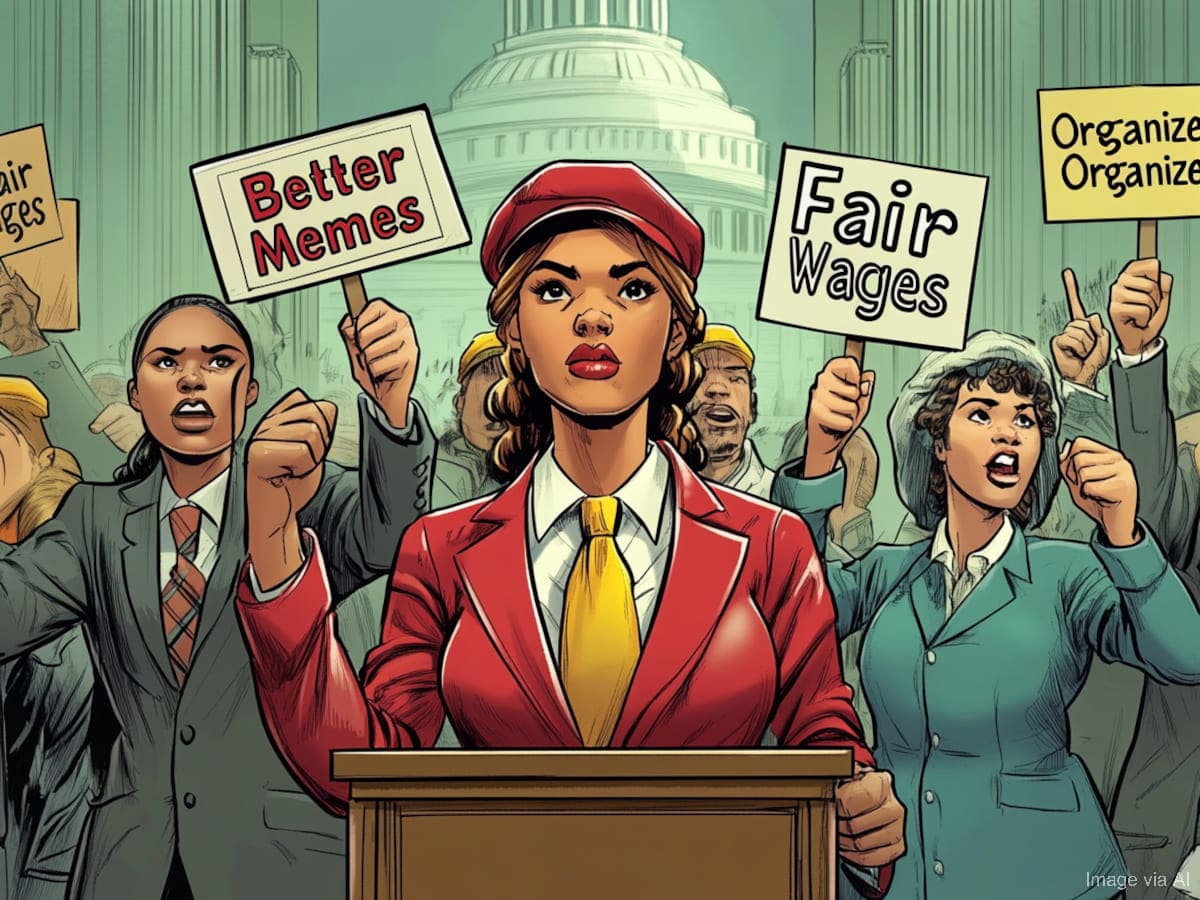
This image works as a political cartoon highlighting the intersection of modern activism and traditional labor rights. At the center stands a woman in a bold red suit and hat, commanding attention as a leader or spokesperson. Behind her, a diverse group of individuals raises fists and holds signs with messages like "Better Memes" and "Fair Wages," blending humor with serious calls for economic justice. The inclusion of "Organize" on a partially visible sign nods to the growing push for collective action and unionization.
The backdrop of a grand government building adds weight to the scene, symbolizing the institutional change these protesters are demanding. This cartoon cleverly mixes humor and advocacy, reflecting the modern era of activism where memes and social media amplify traditional calls for fair wages and workers' rights.
The Broken Bridge

The "Broken Bridge" political cartoon paints a depressing picture of division in America. In the background, two Capitol buildings stand on opposite sides of a gaping chasm. The bridge that once connected them lies in ruins, its shattered pieces scattered in the abyss, and a lone politician stands at the edge, and the bridge is likely crumbling because of his presidency.
And if you look closely, the "bridge" isn't solid ground — it's a jumble of newspapers (probably with screaming headlines like "Fake News!" and "The Other Side is Destroying America!"). Clearly, the broken bridge represents the lack of cooperation between Democrats and Republicans. The politician, standing on a rocky foundation of biased media, exemplifies how some politicians exploit these divisions for personal gain. The cartoon warns that the two-party system leads to further isolation and undermines the very foundation of a healthy democracy – open dialogue and compromise.
The Political Circus

"The Circus" is the least surprising political cartoon A.I. dreamt up in this experiment. Whether you're liberal or conservative, every American has referred to the government as a circus at some point. This cartoon shows a circus tent depicting the U.S. Government. Inside, a range of animals dressed in nice suits fight over a bill, ignoring solutions. Around them, lobbyists throw money, humans clap in the background, and it's basically complete chaos.
This cartoon isn't meant to make you laugh. It cuts straight to the heart of a major problem in American politics: gridlock. Politics can feel like childish fighting, with the real solutions getting lost in the mess and leaving everyone frustrated.
Let's Make a Deal
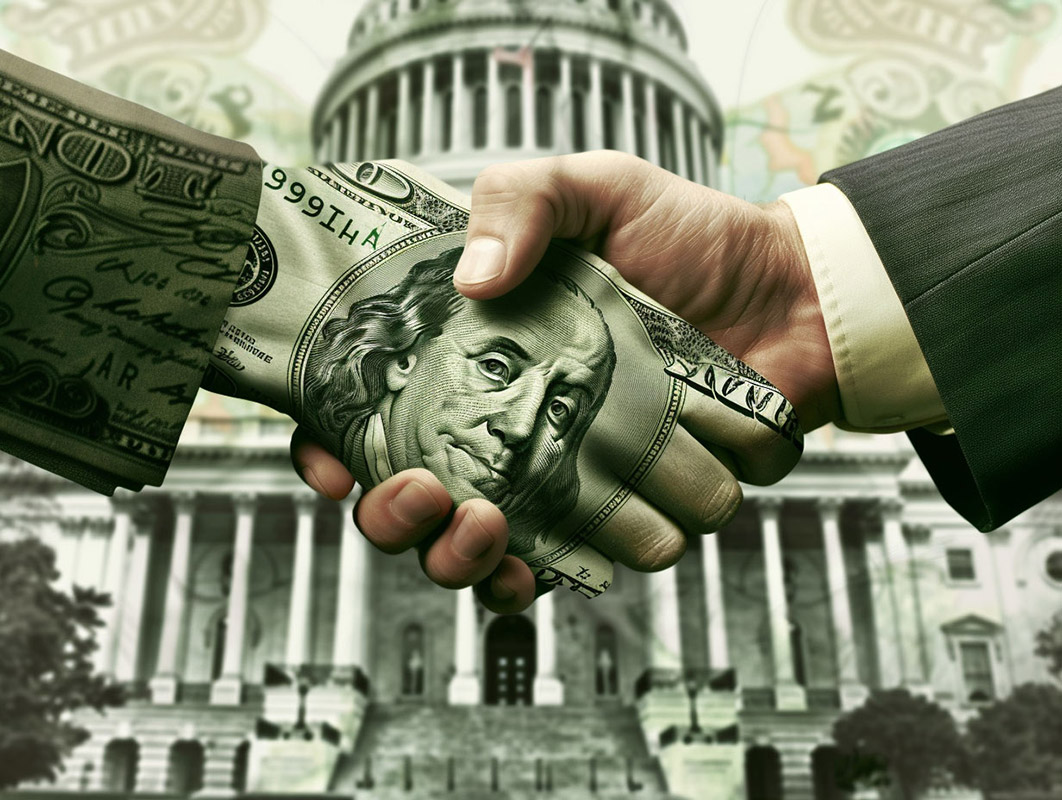
Capitalism and politics go hand-in-hand in America, which is perfectly embodied in this cartoon. Here, a politician shakes hands with a figure made of money in front of the Capitol building, symbolizing the influence of wealth on politics. The handshake between the politician and the money figure represents a deal or agreement being made, suggesting that financial interests often shape political decisions.
The Capitol building in the background reinforces the idea that these dealings occur within the halls of government, highlighting the systemic nature of the issue. By portraying money as a tangible person, the cartoon draws attention to the prevalence of corporate greed influencing lawmakers.
Mitch McTortoise
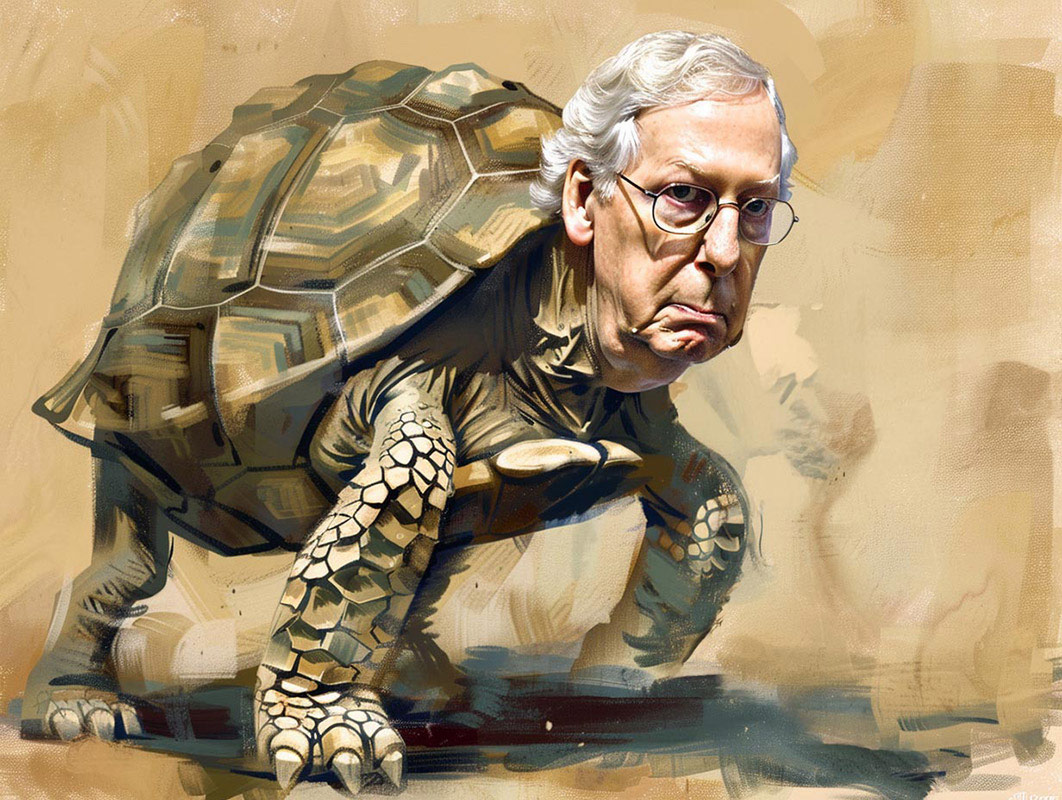
Depicting Mitch McConnell as a tortoise in a political cartoon symbolizes his slow, methodical approach to in advancing his political agenda. Like a tortoise, McConnell is seen as patient, persistent, and protective of his agenda. the tortoise imagery underscores McConnell's reputation for obstructing progress and impeding change, particularly through his use of procedural tactics and Senate rules.
Just as a tortoise may retreat into its shell to avoid confrontation, McConnell has been criticized for his efforts to stifle debate and block legislative initiatives. In the broader context of American politics, this cartoon symbolizes the challenges of reforming the existing political framework and scrutinizes the stubbornness of leaders like McConnell who reject any meaningful attempts at progress.
Don't Tread On Me!

We all know the infamous "Don't Tread on Me" flag from 1775. Here, it's depicted as a colossal snake towering over the Capitol building in Washington and suffocating it. Symbolically, the snake represents multiple things. First, it could be interpreted negatively, suggesting that libertarianism is a perceived threat to the country.
More positively, the imagery emphasizes that Americans shouldn't allow the government to restrict personal freedom, such as bodily autonomy or free speech. The giant snake emphasizes the magnitude of these concerns. Ultimately, the cartoon advocates for a limited government.
The Oval Echochamber
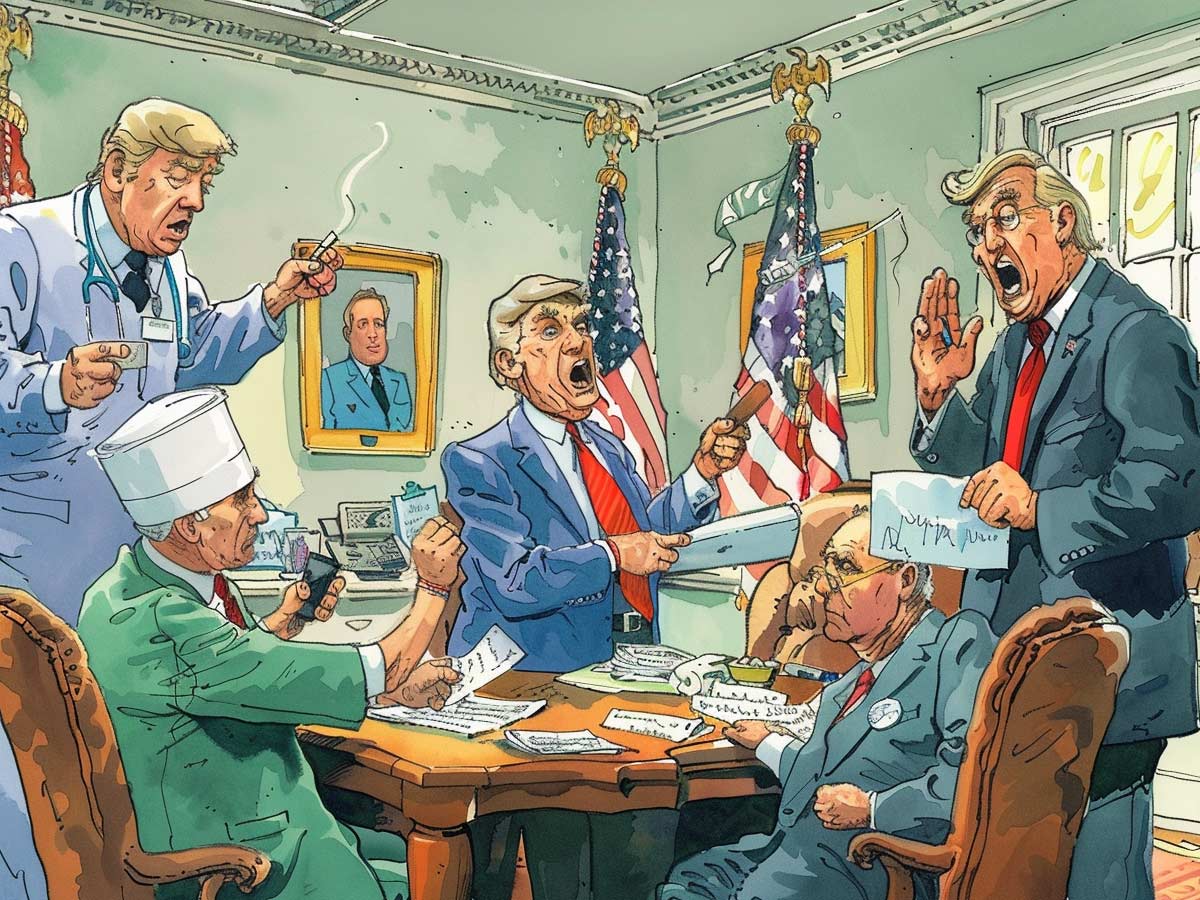
This cartoon is incredibly surreal because it's almost too realistic! In the Oval Office, multiple clones of Donald Trump dressed as different professions engage in a heated argument, which symbolizes how top government officials in the PResidential cabinet merely act as an echo chamber for the president's agenda.
Most people prefer to surround themselves with those who reinforce their own viewpoints and shut out dissenting opinions. But when it comes to politics, that's a dangerous practice, and nobody is better at shutting down the opposition than Donald Trump. Here, each Trump represents a different cabinet position... The only good ideas are his ideas!
Silent or Silenced?
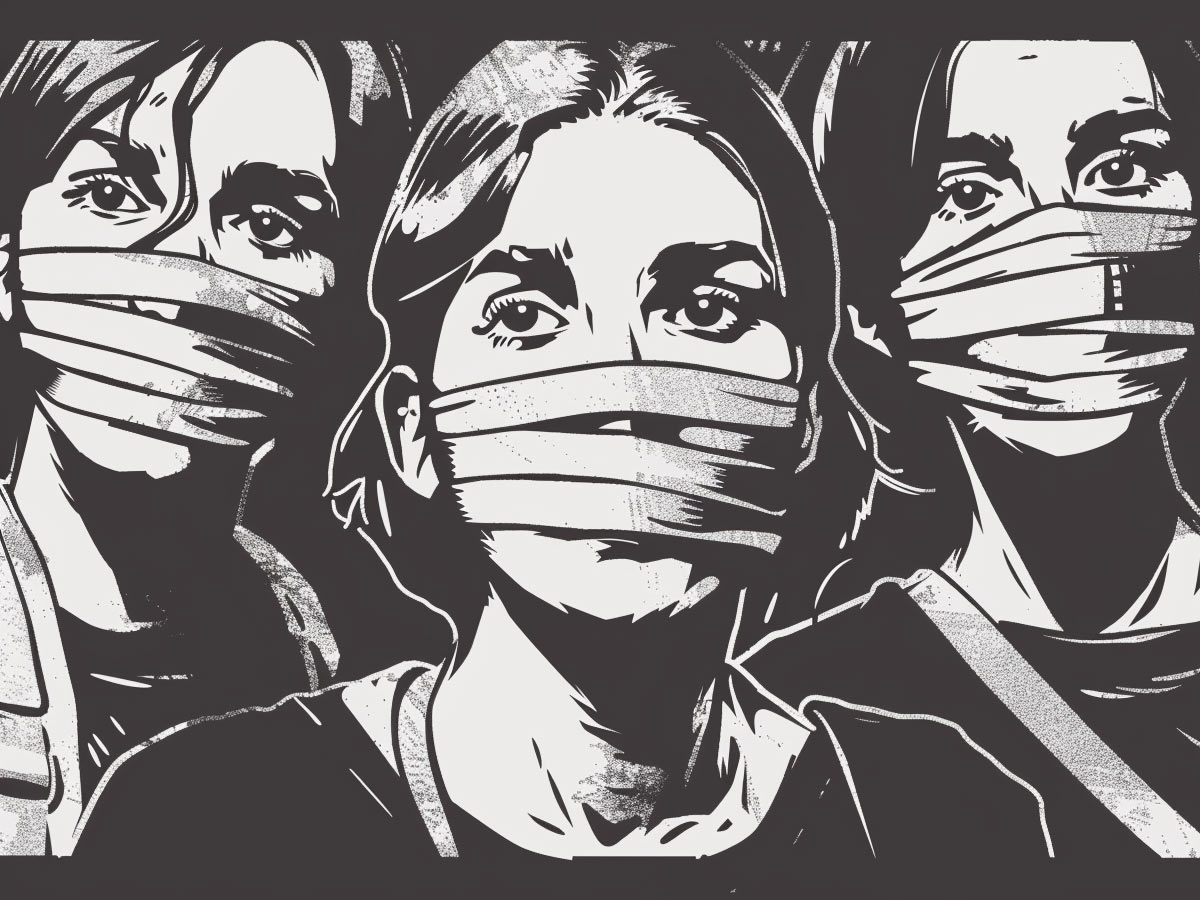
The stark black and white cartoon depicts three young women, their faces etched with defiance. However, all wear identical thick white cloth wrapped around their mouths., representing an inability to speak up. This image represents the silencing of marginalized voices, specifically related to abortion rights, assembly, and protest.
Restrictive abortion laws seek to control their bodies and silence their autonomy. Additionally, student protestors are routinely arrested for speaking up about war, which underscores the broader theme of censorship and suppression.
Prehistoric Politicians
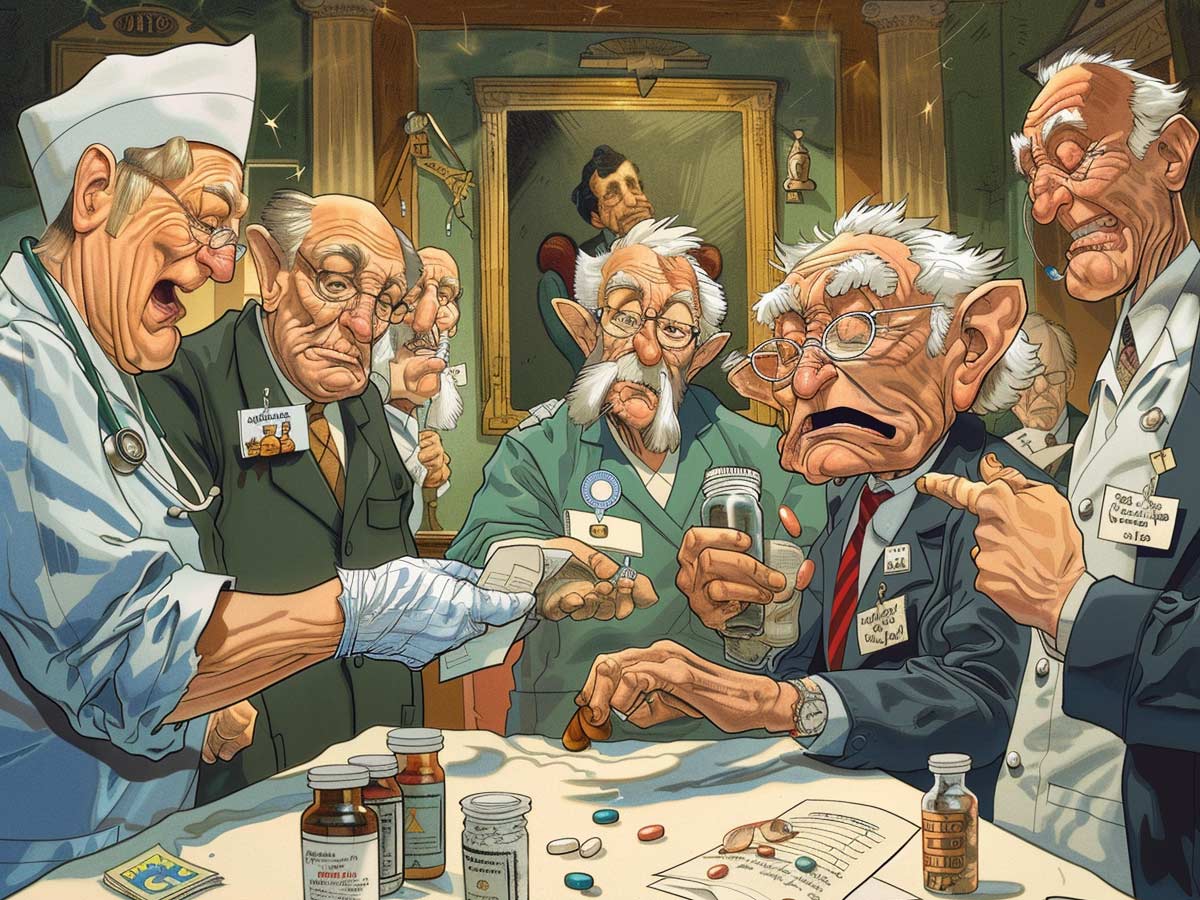
This cartoon is hilarious because it involves elderly politicians gathered in a nursing home surrounded by pills as they discuss policy. Not only does this suggest that our lawmakers are dinosaurs and can't relate to the average concerns of the modern American, but also how outdated the political establishment clings to power despite declining effectiveness.
The political elite are out of touch with the needs of the wider population with the pills further representing their dependence on old ways of thinking.
Meager Mascots

Two weathered and bony animals sit on a stage separated by a squeaky microphone — and we all know that these animals represent the American two-party system. The Republican elephant and the Democratic donkey face each other for a debate, but they look incredibly worse for wear... Should they even be allowed to debate in the first place?
Their meager appearances represent two things: (1). the stagnant nature of the two-party system in American politics, and (2). elderly congressmen! Despite their ineffectiveness, they still dominate modern lawmaking. Plus, legislators on both sides end up arguing so much that they can't make meaningful change anyway!
The Corporate Politicians
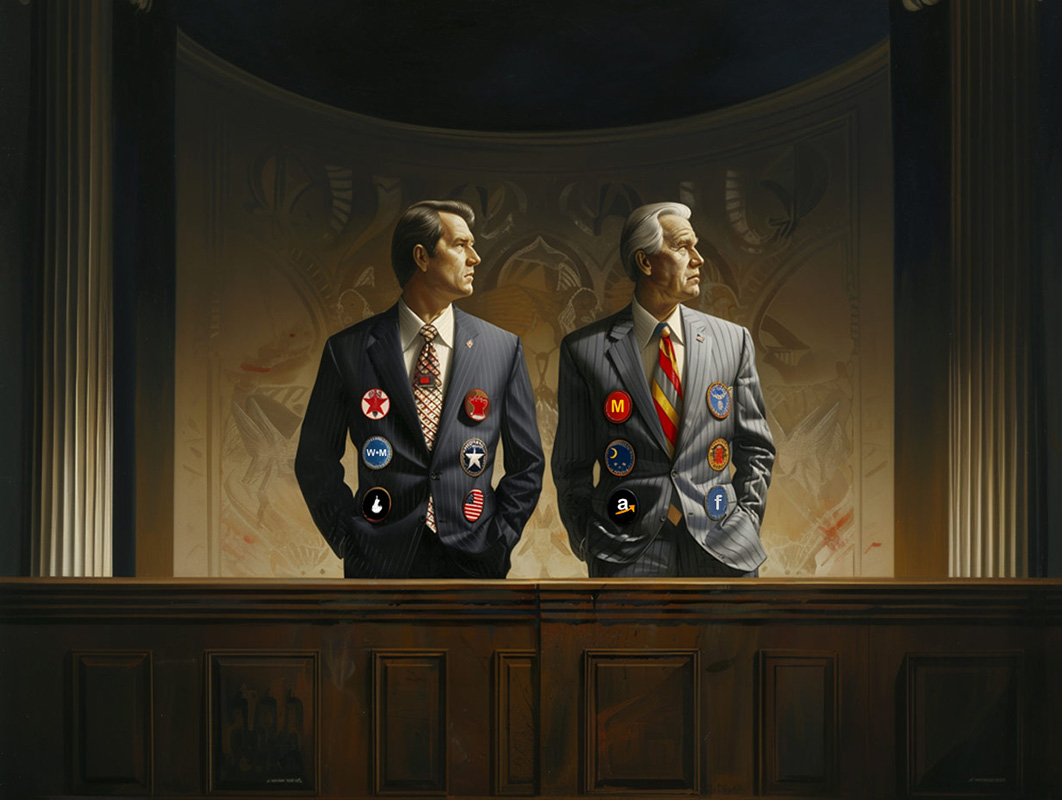
This cartoon is a tale as old as capitalism! Two well-dressed politicians are covered in patches advertising the logos of billion-dollar companies. These politicians aren't really working for the people who voted for them; instead, they're backed by big corporations that lobby against the people's best interests. Who needs universal healthcare if it hurts Eli Lilly's bottom line?
Powerful companies have a lot of say in politics because, unfortunately, money talks way more than votes do these days. It's a reminder that we need to make sure politicians are honest about where their money comes from and who they're really working for.
Making Lemonade out of... Demons?
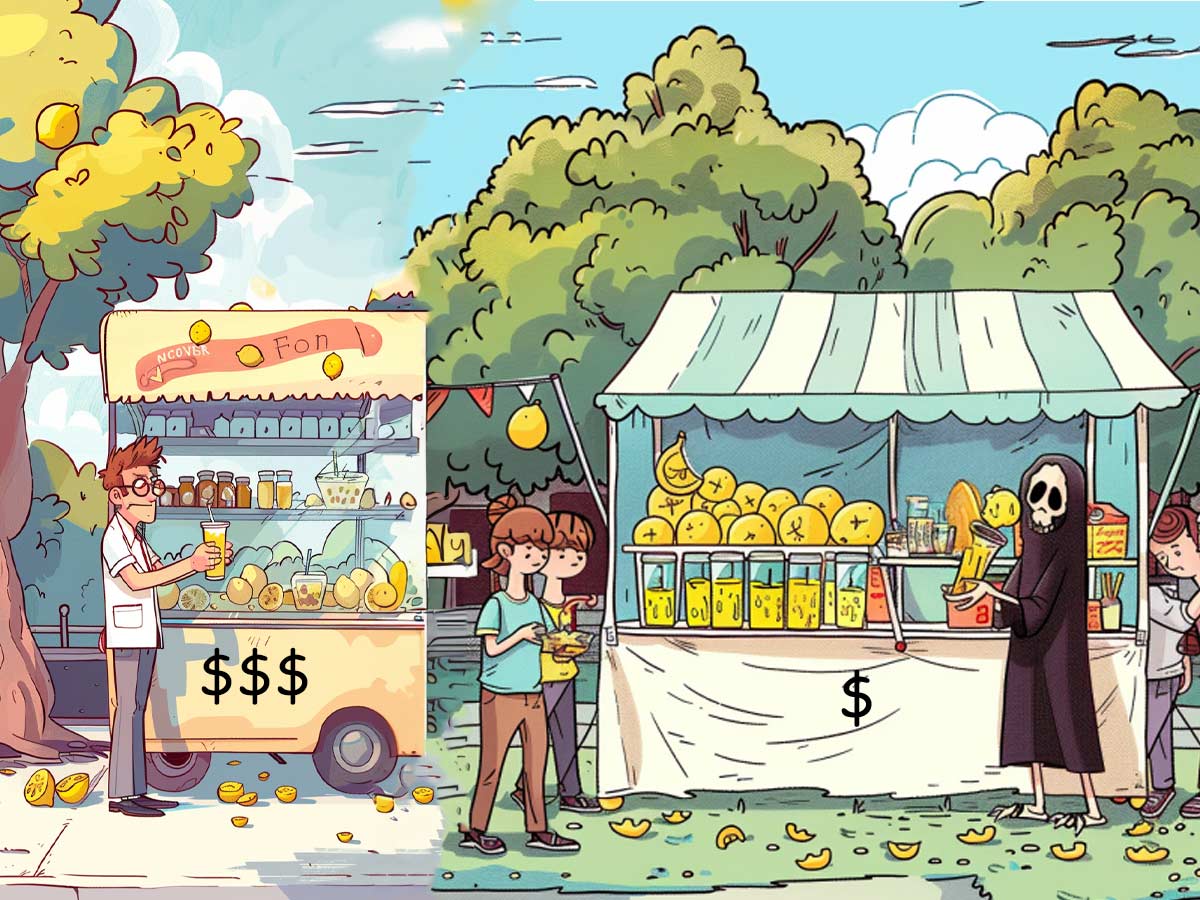
In this cartoon, a doctor and the Grim Reaper run lemonade stands. However, there's a stark difference between the two: the doctor's prices are noticeably higher, and the Grim Reaper attracts more customers. This imagery serves as a pointed critique of the healthcare system, highlighting the profit-driven nature of medical services and the consequences for patients.
The exorbitant costs of healthcare often place financial strain on individuals and deter them from seeking necessary medical treatment. In contrast, the Grim Reaper's popularity suggests that some people may forego medical care altogether. It calls attention to the urgent need for healthcare reform to ensure it's affordable and universal.
High Time for a Bribe
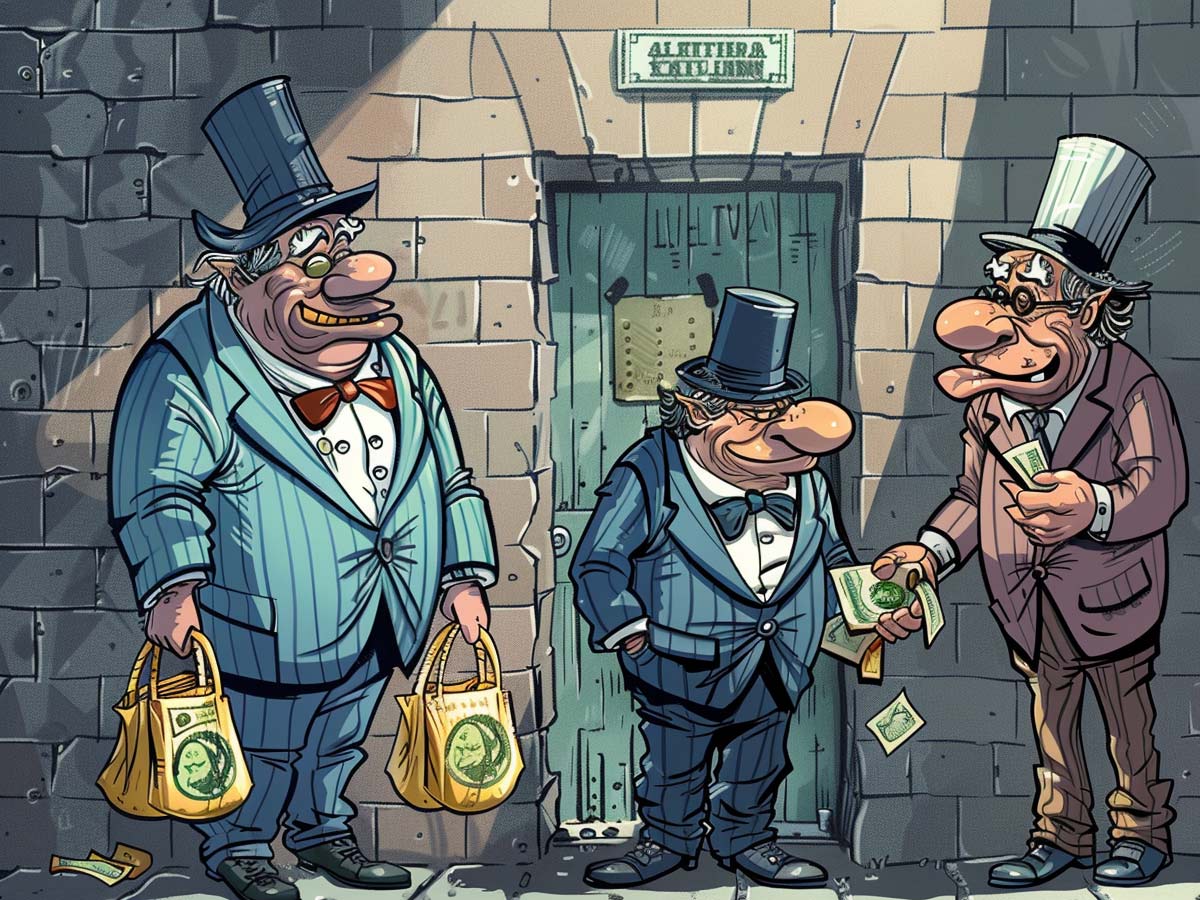
Here, three politicians exchanging fistfuls and bags of money in a dark alleyway, suggesting sketchy alliances between politicians and corporations. Who actually funds campaigns? Lobbyists and corporate CEOs. This image represents "backdoor deals," which is when elected officials prioritize the interests of wealthy donors over the needs of the general public.
Corporate lobbying undermines the integrity of the democratic process. The shadowy alleyway reinforces the secretive and unethical nature of these transactions, which are hidden from public opinion. This cartoon calls attention to the increased need for financial transparency and accountability in all parts of politics.
Labyrinth of Lies

A man navigates through a maze but is repeatedly let astray; this is lawmaking! At every turn, his progress is impeded by various obstacles, including public outcry, lobbying efforts, and broken campaign promises. Proposing policy in Congress is often frustrating because pushing forward meaningful change is often thwarted by people with vested interests.
Grassroots activism has it the worst, because corporate lobbyists are often successful at crushing their campaigns. Ultimately, the cartoon serves as a stark reminder that U.S. lawmaking requires unwavering perseverance, collective action, and — most importantly — giant bank accounts.
Get Out of Jail... Free?

Weirdly enough, even politicians who are actively tried in court can run for political office. Seems silly, right? Here, police officers are depicted gathering campaign donations from within the confines of a prison cell where the politicians are locked up.
This cartoon emphasizes how some politicians (even former Presidents!) don't care about following the law as long as they collect enough cash. Instead, they focus on their own financial gain, even if it means ignoring the needs of the people they represent. There needs to be big changes to stop rich people from having too much influence over politics and to make the political process fairer for everyone.
Municipal Marsh
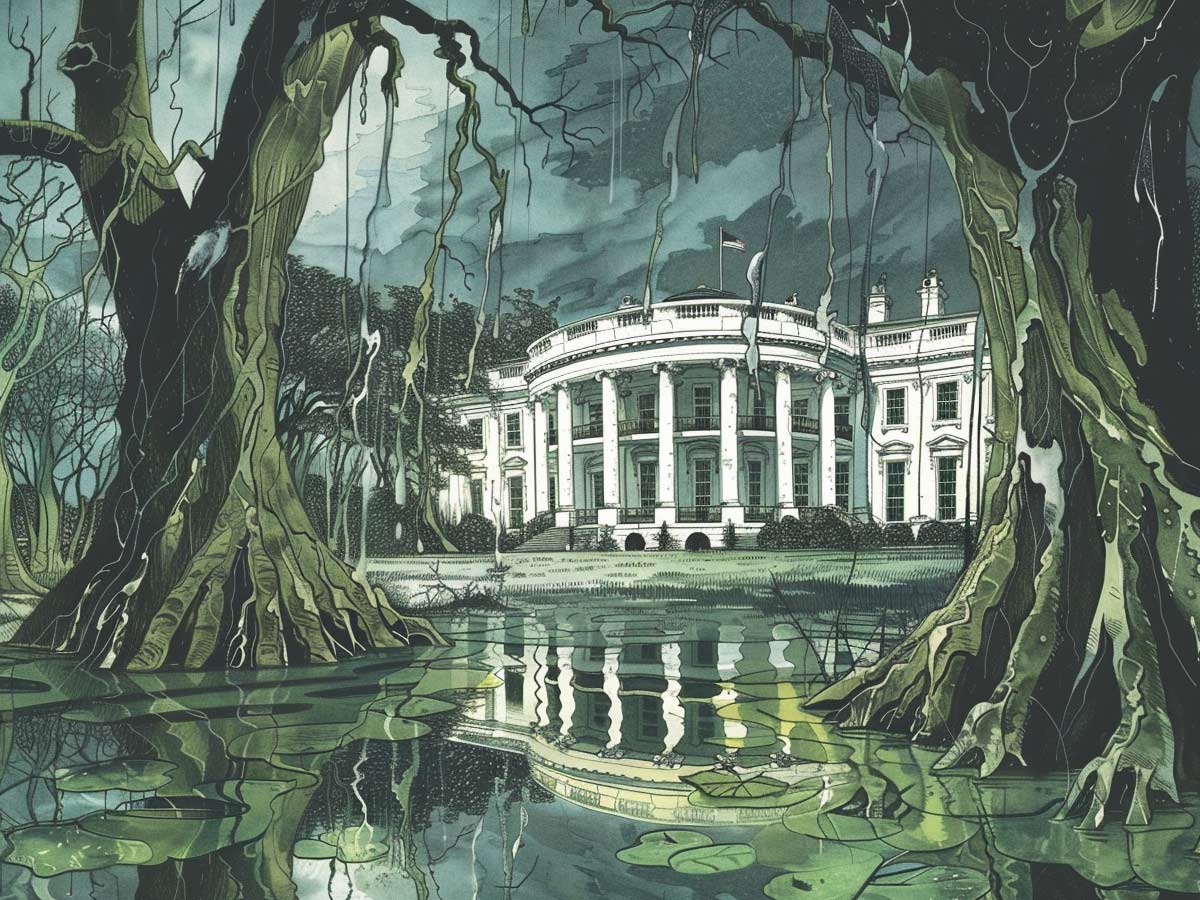
The White House is surrounded by a repulsive swamp, which symbolizes the continued moral decay of the political establishment. The swamp symbolizes the murky and ethically compromised environment of Washington, D.C., where special interests and lobbying often dictate policy to the detriment of American citizens.
Even the highest levels of government are not immune to corruption. The cartoon serves as a heavy reminder of the need to elect ethical leadership in order to drain the metaphorical swamp and restore faith in democracy.
 Author
Rachel Downs
Last Updated: October 25, 2025
Author
Rachel Downs
Last Updated: October 25, 2025